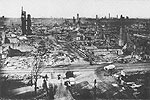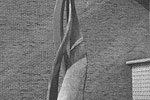
The Loop (continued)
In 1860 Chicago's commerce and industry still centered around
the Chicago River close to the lake. But entrepreneurs were beginning
to look for new locations away from the central business district.
River traffic had become much too heavy, and pollution problems
were already developing. Besides this, the new technology of the
railroad was making manufacturers less depending on the river.
Two of Chicago's major industries moved away from the central
city at this time. In the early 1860s a few meatpacking plants
moved to the South Branch of the Chicago River in Bridgeport.
Then in 1865, when the Union Stock Yard opened on 39th Street
to the southwest of the city, the remaining plants moved to the
Town of Lake. Steel makers also looked for new locations away
from the crowded banks of the Chicago River. In 1875 the first
steel mill opened on the Calumet River and began a trend which
would make the far southeast side of Chicago a steel-producing
center that would eventually surpass Pittsburgh in tonnage. As
the mills, packinghouses, and factories left the downtown area,
so did the workers.
The Chicago Fire also contributed
to the outward movement of the working-class neighborhoods (See
Fig. 1).
A little after nine o'clock on Sunday evening, October 8, 1871
a
fire broke out in the O'Leary barn on DeKoven Street near Jefferson
in the Irish "Patch," just southwest of downtown,
where the Fire Academy stands today. No one knows how the fire
began,
but once it started, the O'Leary name was linked with the tragedy,
and by Tuesday morning most of Chicago was a smoldering ruin.
Nothing could stop the inferno as it first consumed the wooden
houses of the Patch then attacked the "fire-proof" buildings
downtown. Mrs. O'Leary's house stood untouched as the fire
burned
an average of sixty-five acres per hour and destroyed the proud,
young city. Over 1,600 acres lay in ashes from the Near West
Side
to the lake and up to Fullerton Avenue north of the river. To
many people the fire seemed to mark the end of Chicago.
To many others, however, it presented an opportunity. The fire
did not touch the industry that had moved to the outskirts of
the city. While the fire consumed the lakefront, the Union Stock
Yard continued its processing of hogs, cattle, and sheep. The
newer grain elevators away from downtown were ready to take an
additional produce. Railroad tracks, twisted and destroyed near
the heart of the city, still came in from the East. Money, too,
soon arrived. The Chicago Fire drastically affected the insurance
business, but investors soon saw that the city had great potential
for new growth. The important Eastern connections that had helped
to create Chicago now helped to resurrect it. The city rose like
a phoenix from the fire.
«
previous
5
of 11 next
»
|
 |

|
 |


Figure
1: Fire of 1871, looking north on Clark Street from Cook County Court
House and City Hall. »

Figure
2: Pillar of Fire, Jefferson and DeKoven Streets, 1985. »
|